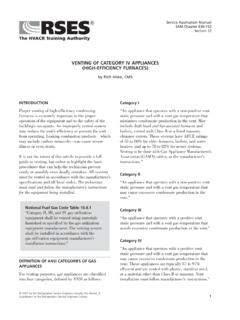Transcription of The Basics for Investing Stocks s k c t S
1 By the Editors of Kiplinger sPersonal FinancemagazineStocksInvestinginThe Basics forStocksIn partnership withfor 2| The Basics for Investing in StocksTable of Contents 2005 by The Kiplinger Washington Editors, Inc. All rights Kinds of Stocks2A Smart Way to Buy Stocks3 What You Need to Know6 Where to Get the Facts You Need7 More Clues to Value in a Stock8 Dollar-Cost Averaging9 Reinvesting Your Dividends12 When to Sell a Stock13 How Much Money Did You Make?13 Mistakes Even Smart Investors Make &How to Avoid Them14 Protect Your Money: How to Check Out a Broker or AdviserGlossary of Investment Terms You Should KnowAbout the Investor Protection TrustThe Investor Protection Trust (IPT) is a nonprofit organization devot-ed to investor education.
2 Over half of all Americans are now investedin the securities markets, making investor education and protectionvitally important. Since 1993 the Investor Protection Trust hasworked with the States and at the national level to provide the inde-pendent, objective investor education needed by all Americans tomake informed investment decisions. The Investor Protection Truststrives to keep all Americans on the right money track. For additionalinformation on the IPT, visit Kinds of Stocks | 1No other investment availableholds as much potential asstocks over the long run. Not real estate. Not bonds. Not savingsaccounts. Stocks aren t the only things that belong in your investmentportfolio, but they may be the most important, whether they re pur-chased individually or through stock mutual 1926, the Stocks of large companies have produced an average annual return ofmore than 10%.
3 (Remember, that includes such lows as the Great Depression, BlackMonday in 1987 and the stock slide that followed September 11.) You don t have to beat the market to be successful over time. There is risk involved,as there is in all investments, but the important thing is to balance the amount ofrisk you re willing to take with the return you re aiming Kinds of StocksFirst it s important to understand what a stock is. When investors talk about Stocks ,they usually mean common Stocks . A share of common stock represents a share ofownership in the company that issues it. The price of the stock goes up and down,depending on how the company performs and how investors think the company willperform in the future.
4 The stock may or may not pay dividends, which usually comefrom profits. If profits fall, dividend payments may be cut or companies also issue preferred stock. Like common stock, it is a share ofownership. The difference is preferred stockholders get first dibs on dividends in good times and on assets if the company goes broke and has to , the price of preferred stock can rise or fall along with the common . In reality it doesn t move nearly as much because preferred investors are interestedmainly in the dividends, which are fixed when the stock is issued. For this reason,preferred stock is more comparable to a bond than to a share of common s hard to think of a compelling reason to buy preferred Stocks .
5 They generally paya slightly lower yield than the same company s bonds and are no safer. Their poten-tial equity kicker (the chance that the preferred will rise in price along with thecommon stock) has been largely illusory. Preferred stock is really better suited forcorporate portfolios because a corporation doesn t have to pay federal income tax onmost of the dividends it receives from another corporation. Stocks are bought and sold on one or more of several stock markets, the bestknown of which are the New York Stock Exchange (NYSE), the American StockExchange (AMEX), and Nasdaq. There are also several regional exchanges, rangingfrom Boston to Honolulu.
6 Stocks sold on an exchange are said to be listed there; Stocks sold through Nasdaq may be called over-the-counter (OTC) are lots of reasons to own Stocks and there are several different categories ofstocks to fit your goals. GROWTH Stocks have good prospects for growing faster than the economy or thestock market in general and in general are average to above average risk. Investorsbuy them because of their good record of earnings growth and the expectation thatthey will continue generating capital gains over the long STOCKSwon t be found on an official Blue Chip Stock list. Blue-chip Stocks are generally industry-leading companies with top-shelf financial Since 1926, thestocks of largecompanies haveproduced anaverage annualreturn of morethan 10%.
7 2| The Basics for Investing in Stockscredentials. They tend to pay decent, steadily rising dividends, generate somegrowth, offer safety and reliability. and are low-to-moderate risk. These Stocks canform your retirement portfolio s core holdings a grouping of Stocks you plan tohold forever, while adding other investments to your STOCKSpay out a much larger portion of their profits (often 50% to80%) in the form of quarterly dividends than do other Stocks . These tend to bemore mature, slower-growth companies, and the dividends paid to investors makethese shares generally less risky to own than shares of growth or small-companystocks. Though share prices of income Stocks aren t expected to grow rapidly, thedividend acts as a kind of cushion beneath the share price.
8 Even if the market ingeneral falls, income Stocks are usually less affected because investors will stillreceive the STOCKSare called that because their fortunes tend to rise and fall with those of the economy at large, prospering when the business cycle is on theupswing, suffering in recessions. Automobile manufacturers are a prime example,which illustrates the important fact that these categories often overlap. Other indus-tries whose profits are sensitive to the business cycle include airlines, steel, chemi-cals and businesses dependent on home STOCKSare theoretically insulated from the business cycle (and there-fore lower in risk) because people go right on buying their products and services inbad times as well as good.
9 Utility companies fit here (another overlap), as do compa-nies that sell food, beverages and drugs. VALUE Stocks earn the name when they are considered underpriced according toseveral measures of value described later in this booklet. A stock with an unusuallylow price in relation to the company s earnings may be dubbed a value stock if itexhibits other signs of good health. Risk here can vary STOCKSmay be unproven young dot-coms or erratic or down-at-the-heels old companies exhibiting some sort of spark, such as the promise of animminent technological breakthrough or a brilliant new chief executive. Buyers ofspeculative Stocks have hopes of making big profits.
10 Most speculative Stocks don tdo well in the long run, so it takes big gains in a few to offset your losses in themany. Risk here, no surprise, is Smart Way to Buy StocksThe secret to choosing good common Stocks is that there really is no secret to winning techniques are tried and true, but it s how you assemble and applythem that makes the difference. Information is the key. Having the right information about a company and knowinghow to interpret it are more important than any of the other factors you might hearcredited for the success of the latest market genius. Information is even more impor-tant than timing. When you find a company that looks promising, you don t haveto buy the stock today or even this week.









